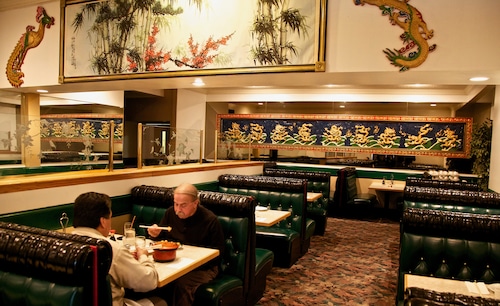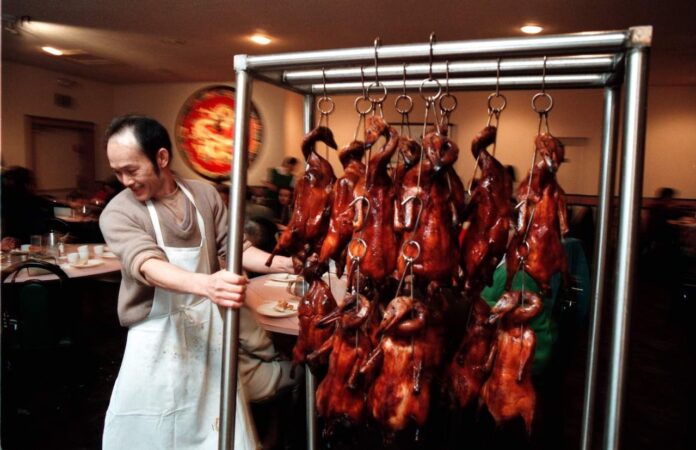In the 1940s, Canton Grill was the first Chinese American restaurant to open at the intersection of Southeast 82nd Avenue and Division Street. Today, the storied restaurant is at the heart of a project to honor the culinary history of the area now known as Portland’s Jade District.
Canton Grill founder Fred Louis Sr. was born in Guangzhou, China, in 1903, and came to the United States in 1919, according to his obituary. He received a chemistry degree from Tri-State College in 1929 but couldn’t find work.
“When you do a job application, and your name is L-O-U-I-E, they just put you in the pile they don’t call back,” his son Fred Louis Jr. recalled in a video interview. “My father, despite being college-educated, couldn’t get a job. He even changed our last name (to Louis) to sound more American to get employed.”
In 1934, Fred Sr. – now with the last name Louis – moved to Portland. Ten years later, he and several friends opened the Canton Grill at 2610 S.E. 82nd Ave., then at the edge of Portland’s city limits.
“I think the landlord was desperate, and the rent was cheap,” Louis Jr. recalled.
From that modest beginning, Canton Grill built a community.
Over 78 years, three generations of the Louis family ran the restaurant, lounge and banquet room until it closed in 2020 in the midst of the pandemic.
Today, APANO, the Asian Pacific American Network of Oregon, is reimagining the future of the former Canton Grill while also preserving its past.
The nonprofit’s new digital archive project, called Behind the Wok, officially launches May 30 at apano.org/behind-the-wok.
Visitors to the site can explore the history of six longtime Chinese American restaurants along 82nd Avenue with video interviews, stories and photos from Hung Far Low (1928-2012), Canton Grill (1944-2020), Chinese Village (1946-2018), New Cathay (1949-1987), Legin (1995-2012) and Wong’s King Seafood (2005-2020).
“Eighty-second Avenue has become a very diverse area for immigrants, and these are some of the pioneers that paved the way,” said Brian Liu, community development manager at APANO. “We’ve seen people come and go, and these are some of the pioneers that built a presence in the area.”
In 2023, APANO purchased the former Canton Grill for $2.6 million with funding from the American Rescue Plan Act.
APANO plans to redevelop the property with affordable housing, community spaces and commercial areas. They’ve created a master site plan but are still seeking funding to complete the project.
The building itself is in disrepair and will likely be demolished, Liu said, though early plans call for preserving its towering vertical sign.
Canton Grill, at 2010 S.E. 82nd Ave., an undesignated resource that may be significant for Asian American history.
“ I think this archive will be used potentially to inspire some of our cultural placemaking strategies on the site,” Liu said. “ If we can use some of the stories or some of the iconic design that could incorporate it into the new building, that would be great.”
But Behind the Wok goes beyond the Canton Grill to tell stories from other Chinese restaurants that became community hubs in what later became the Jade District.
Many Portlanders will remember Hung Far Low for its longtime location in Chinatown, where it opened in 1928, and its iconic vertical sign, which still stands at Northwest Fourth Avenue and Couch Street.
The name comes from “Hahn Fah Low,” which means “almond blossom fragrance.”
The restaurant moved to Southeast 82nd Avenue in 2005, around the same time that ongoing streetscape construction drove many businesses from Chinatown.
“Even though the city said you can continue business, who wants to go to Chinatown when a jack hammer is blasting and it’s dusty, there’s no place to park,” said urban designer Suenn Ho, who worked on the Behind the Wok project. “The wish for gentrification in Chinatown ended up killing a lot of small businesses.”
Hung Far Low closed in 2015, after 87 years in business.
Another midcentury restaurant and cocktail lounge known for its towering sign, Chinese Village operated from 1946 to 2018 at the intersection of Southeast Washington Street and 82nd Avenue.
Founder Chan Bak Wo helped many immigrants, particularly those from his home village in Taishan, Guangdong Province, obtain employment visas by providing them jobs at his restaurant.
New Cathay, on the northeast corner of 82nd and Division, served the community from 1949 to 1987. Its owner, Bob Louie, “arrived in America as a teenager with hopes of a better life and a commitment to supporting his family,” reads a biography on Behind the Wok.
Louie began his restaurant career as a waiter at Huber’s – Portland’s oldest continuously operating restaurant. After serving in the Navy during World War II, he resumed his restaurant career.
In the mid-20th century, these “chop suey” restaurants, which served an Americanized version of Chinese cuisine, took hold on the east side.
The restaurants later struggled as younger generations favored more “authentic” Chinese cuisine, Ho said, but she found “a richness in that culinary culture” as she interviewed former restaurant owners.
“It has a lot of heart, and there’s a story that is really about immigrants,” she said. “They’re in a different place, different culture, different ingredients are available, and who am I to judge whether that’s authentic or not?”
Legin, a restaurant, bar and banquet hall, closed in 2012 after 17 years in business. In a story reporting the closure, The Oregonian/OregonLive’s Michael Russell wrote that Legin was “remarkable … for its pioneering east side location and for that massive hall, a key gathering place for Portland-area Asian communities.”
That property, at 8001 S.E. Division St., was purchased by Portland Community College and is being developed into an affordable housing complex with 124 units, set to open next year. It’s called Legin Commons, in a nod to its former life as a restaurant.

In a file photo from 2012: “Adan Serrano, left, and Benny Bland have been coming to Legin Restaurant for a long time. They love the food and will miss the restaurant when it closes on Oct. 21.”Benjamin Brink/The Oregonian
Wong’s King Seafood opened in 2004, as part of a wave of Chinese haute cuisine restaurants to open in the Jade District.
“ The old restaurants were more traditional chop suey houses, American Chinese flavors,” Liu said. “Wong’s King is the very first, in a sense, Chinese restaurant in the area.”
In 2010, Wong’s King Seafood was named the third best Chinese restaurant in America by Chinese Restaurant News magazine. The restaurant closed in 2020 due to the pressures of the pandemic.
Behind the Wok gives digital visitors much to explore, with timelines that chronicle the restaurants through the years, photos of menus and old advertisements and video interviews with owners and their descendants. APANO received a Mellon Foundation grant for the project.
Interviewing elders in the restaurant community, Ho said, “had a sense of urgency.”
“It has a level of preciousness, and you try to pull out the most endearing, memorable parts of their lives,” she said.
Liu said the goal of the project is two-fold: to preserve the neighborhood’s history and also to feature current businesses still struggling since the pandemic.
“We want to shed light on how some of these entrepreneurs were able to sustain given the hardships that they’ve experienced,” he said. “That kind of resiliency is something we want to highlight as well.”
APANO also hopes to expand Behind the Wok over time.
“If we get future funding, we’re hoping this could be a living document that’s not just focused on Chinese restaurants but, given how diverse the Jade District is, honors different waves of immigrants that have built that space,” Liu said.
If you have stories, photos or other memories of historic restaurants in the Jade District to share for Behind the Wok, contact APANO at press@apano.org.
— Samantha Swindler covers features for The Oregonian/OregonLive and Here is Oregon. Reach her at sswindler@oregonian.com.
Our journalism needs your support. Subscribe today to OregonLive.com.

